List of English chief ministers
The retroactive and informal position of chief minister was given to the various personages who presided over the government of England and subsequently Great Britain at the pleasure of the monarch, usually with said monarch's permission, prior to the government under Robert Walpole as Prime Minister in 1721.
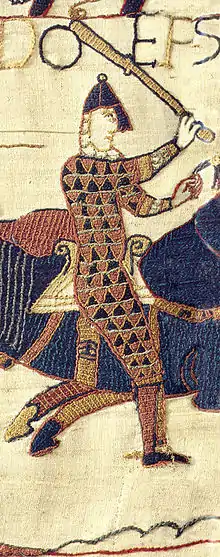
The "chief ministership", being an informal capacity, had many titles, sometimes none at all, and while usually a single person, could be held by groups of up to three or four.
Era of royal favourites, regents and rivals (946–1649)
Anglo-Saxons
.jpg.webp)
- 940–957: Æthelstan Half-King; so called because he had almost as much power as the king himself
- 946–955: Dunstan, Archbishop of Canterbury; forced into exile by Eadwig from 955 to 957
- 959–978: Dunstan, Archbishop of Canterbury; returned when Edgar the Peaceful became King in Mercia
- 1022–1051: Godwin, Earl of Wessex
- 1053–1066: Harold, Earl of Wessex (the future Harold II, King of England), second son of Godwin, Earl of Wessex
Norman/Angevin rule
William the Conqueror
- 1068–1080: Odo, Earl of Kent
- 1070–1089: Lanfranc, Archbishop of Canterbury
William II of England and Henry I
- 1094–1100: Ranulf Flambard, Bishop of Durham
- 1100–1139: Roger, Bishop of Salisbury
Early Plantagenets

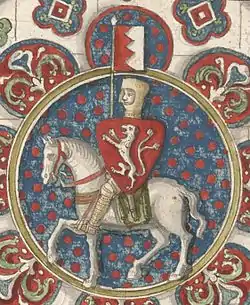
- 1155–1162: Thomas à Becket, Archbishop of Canterbury; assassinated in 1170 and canonised in 1173
- 1189–1199: William de Longchamp, intermittently, during the absences of Richard I (on crusade, in prison, and in France)
- 1214–1219: William Marshal, 1st Earl of Pembroke; Regent of England
- 1219–1232: Hubert de Burgh, 1st Earl of Kent; Regent from 1219 to 1227
- 1263–1265: Simon de Montfort, 6th Earl of Leicester †; killed at the Battle of Evesham
- 1274–1292: Robert Burnell, Bishop of Bath and Wells
- 1309–1311: Piers Gaveston, 1st Earl of Cornwall
- 1327–1330: Roger Mortimer, 1st Earl of March, Regent
- 1327–1330: Queen Isabella of France, Regent (de facto)
- 1327–1330: Henry, 3rd Earl of Lancaster, Regent (de jure)
- 1330–1340: John de Stratford, Archbishop of Canterbury
- 1367–1371: William of Wykeham, Bishop of Winchester
- 1389–1391: William of Wykeham, Bishop of Winchester
House of Lancaster
- 1413–1417: Henry Beaufort, Cardinal, Bishop of Winchester
- 1422–1435: John, Duke of Bedford, Regent, died 14 September 1435
- 1422–1437: Humphrey, Duke of Gloucester, Regent, died 23 February 1447
- 1424–1427: Henry Beaufort, Cardinal, Bishop of Winchester
- 1432–1447: Henry Beaufort, Cardinal, Bishop of Winchester
- 1447–1450: William de la Pole, 1st Duke of Suffolk
- 3 April 1454 – February 1455: Richard Plantagenet, 3rd Duke of York
- 19 November 1455 – 25 February 1456: Richard Plantagenet, 3rd Duke of York, Protector (Regent) for King Henry VI
- 1470–1471: Richard Neville, 16th Earl of Warwick †; known as Warwick the Kingmaker; killed at the Battle of Barnet
House of York
- 1461–1467: Richard Neville, 16th Earl of Warwick; known as Warwick the Kingmaker
- 1475–1483: Thomas Rotherham, Archbishop of York
- 30 April – 26 June 1483: Richard Plantagenet, Duke of Gloucester, was Lord Protector of the Realm during the nominal reign of 12-year-old King Edward V (one of the "Princes in the Tower"), before claiming the throne for himself as King Richard III
House of Tudor
House of Stuart
The Stuart Restoration
This is very true: for my words are my own, and my actions are my ministers.
In 1660, the leadership of the Commonwealth recalled Charles II and the chief minister became responsible to some extent to Parliament as leader of a ministry, although much of the time King Charles was in effect his own chief minister. The Glorious Revolution of 1688–89 furthered this process and by the time of Queen Anne in 1702, monarchs had little choice as to who their ministers would be.
Charles II and James II
| Portrait | Minister(s) (Birth–Death) |
Term of office | Ministerial offices | Party | Election | Ministry | ||
|---|---|---|---|---|---|---|---|---|
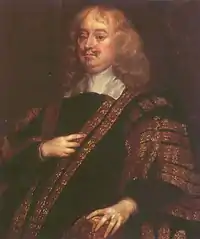 |
1st Earl of Clarendon (1609–1674) |
1660 | 1667 | First Lord of the Treasury (1660) Chancellor of the Exchequer (1660–61) Lord Chancellor |
N/A | 1661 | Clarendon | |
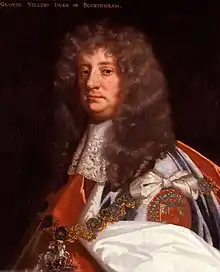 Buckingham |
The C.A.B.A.L.
|
1667 | 1674 | N/A | Cabal | |||
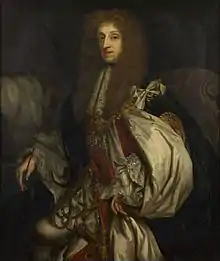 |
1st Earl of Danby (1632–1712) |
1674 | March 1679 | Lord High Treasurer | Tory | N/A | Danby I | |
 Temple |
The Privy Council chaired by Sir William Temple (1628–1699) |
April 1679 | November 1679 | N/A | Privy Council | |||
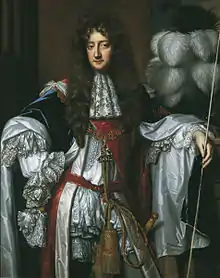 Rochester .jpg.webp) Godolphin  Sunderland |
1st Earl of Rochester (1642–1711) & 1st Earl of Godolphin (1645–1712) & 2nd Earl of Sunderland (1641–1702) |
November 1679 | 1687 | (Rochester:) First Lord of the Treasury (1679–84) (Godolphin:) First Lord of the Treasury (1684–85) (Sunderland:) Northern Secretary (1679–80 & 1683–84) (Godolphin:) Northern Secretary (1684) (Sunderland:) Southern Secretary (1680–81 & 1684–88) (Rochester:) Lord High Treasurer (1685–87) |
Tory | 1681 | The Chits | |
| 1685 | ||||||||
William III and Mary II
| Portrait | Minister(s) (Birth–Death) |
Term of office | Ministerial offices | Party | Election | Ministry | ||
|---|---|---|---|---|---|---|---|---|
 Carmarthen 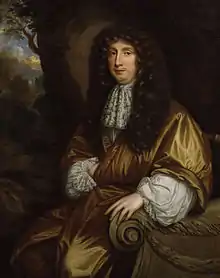 Halifax |
1st Marquess of Carmarthen (1632–1712) & 1st Marquess of Halifax (1633–1695) |
1689 | 8 February 1690 | (Carmarthen:) Lord President of the Council (Halifax:) Lord Privy Seal |
N/A | 1689 | Carmarthen–Halifax | |
 |
1st Marquess of Carmarthen (1632–1712) |
February 1690 | 1695 | Lord President of the Council | Tory | 1690 | Carmarthen | |
From 1693 and during the sole reign of William III, the government was increasingly dominated by the Whig Junto.
Anne
The Kingdoms of England and Scotland united to form the Kingdom of Great Britain in 1707.
| Portrait | Minister(s) (Birth–Death) |
Term of office | Ministerial offices | Party | Election | Ministry | ||
|---|---|---|---|---|---|---|---|---|
.jpg.webp) Godolphin .jpg.webp) Marlborough |
1st Earl of Godolphin (1645–1712) & 1st Duke of Marlborough (1650–1722) |
1702 | 1710 | (Godolphin:) Lord High Treasurer (Marlborough:) Master-General of the Ordnance |
Tory | 1702 | Godolphin–Marlborough | |
| 1705 | ||||||||
| 1708 | ||||||||
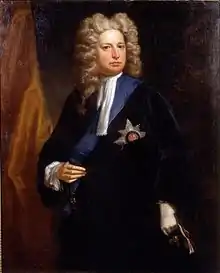 |
Robert Harley (1661–1724) |
1710 | 30 July 1714 | Chancellor of the Exchequer (1710–11) Lord High Treasurer (1711–14) |
Tory (formerly Whig) |
1710 | Harley | |
| 1713 | ||||||||
 |
1st Duke of Shrewsbury (1660–1718) |
30 July 1714 | 13 October 1714 | Lord High Treasurer | Tory | N/A | ||
The Hanoverian Succession
In the immediate aftermath of the death of Queen Anne in 1714, the monarchy was unable to function as the new King was in his domains in Hanover and did not know of his accession. As a stopgap, Parliament elected Thomas Parker, 1st Earl of Macclesfield Regent, or "acting king" until the new monarch arrived to take his crown. Later, George, Prince of Wales reigned as regent for six months from July 1716 to January 1717 when the King went to Hanover.
In the early part of the reign of George I, who could not speak English, the cabinet began meeting without the monarch present.
Following the succession of George I and the resignation of the Duke of Shrewsbury in 1714, the office of Lord High Treasurer went into permanent commission, its function undertaken by a commission of Lords of the Treasury, chaired by the First Lord of the Treasury, rather than by an individual Lord High Treasurer. From 1714 to 1717 the ministry was led by Viscount Townshend, who was nominally Northern Secretary; the Earl of Halifax, the Earl of Carlisle and Sir Robert Walpole successively served alongside Townshend as nominal First Lord of the Treasury. From 1717 to 1721 Lords Stanhope (First Lord 1717–18) and Sunderland (First Lord 1718–21) led the administration jointly, with Stanhope managing foreign affairs and Sunderland managing home affairs. Stanhope died in February 1721 and Sunderland resigned in April 1721; Townshend and Walpole returned to office.
Thus the First Lord of the Treasury came to be the most powerful minister and the prototype of Prime Minister of the United Kingdom and its dominions.
George I
| Portrait | Minister(s) (Birth–Death) |
Term of office | Ministerial offices | Party | Election | Ministry | ||
|---|---|---|---|---|---|---|---|---|
.jpg.webp) |
2nd Viscount Townshend (1674–1738) |
13 October 1714 | 1716 | Northern Secretary | Whig | 1715 | Townshend | |
 Stanhope 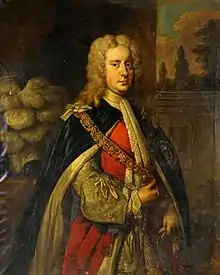 Sunderland |
1st Viscount Stanhope (c. 1673–1721) & 3rd Earl of Sunderland (1675–1722) |
12 April 1717 | 21 March 1718 | (Stanhope:) First Lord of the Treasury Chancellor of the Exchequer (Sunderland:) Northern Secretary |
Whig | N/A | Stanhope–Sunderland I | |
| 21 March 1718 | 4 April 1721 | (Sunderland:) First Lord of the Treasury (Stanhope:) Northern Secretary |
Whig | Stanhope–Sunderland II | ||||
See also
References
- Collier's Encyclopedia, 9, Electron Gun to Fischer, pp. 184–185
- Collier's Encyclopedia, 11, Germanium to Heath Hen, pp. 372–373
- Knowles, Elizabeth M. (1999), The Oxford Dictionary of Quotations, Oxford University Press, ISBN 978-0-19-860173-9
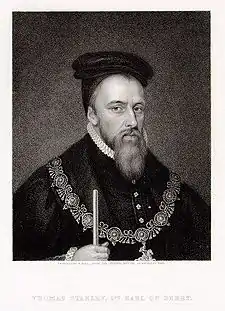
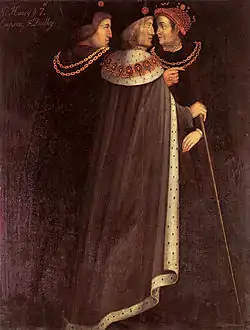
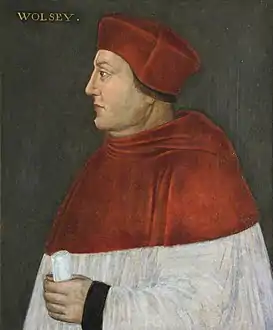

01.jpg.webp)
.JPG.webp)
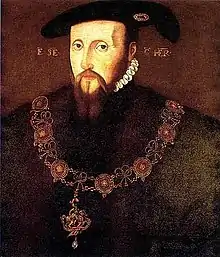
.jpg.webp)
_(14579762630).jpg.webp)

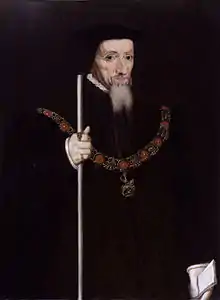


.jpg.webp)


.jpg.webp)



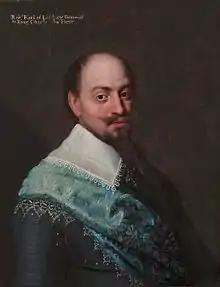
%252C_paltsgraaf_aan_de_Rijn_Rijksmuseum_SK-A-3927.jpeg.webp)
.svg.png.webp)